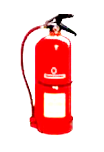What is Health and Safety Management
Health and Safety Management and Responsibilities, Effectiveness of roles and responsibilities about health and safety management essential for security management...
What is Health and Safety Management
Fire is a process of rapid oxidation at high temperatures. This releases hot gases,
Light and invisible forms of radiation energy.
Fire one bye-The product of a rapid combustion reaction. • Combustion to a . is defined as a self-sustaining process of rapid oxidation of
Combustible material (fuel), production of heat and light. •
Oxidation is the process of chemically combining oxygen with other
materials.
- Electrical
- Chemical
- Thermal
- Radioactive
fire requires three
Elements: Heat, fuel, and an oxidizing agent, usually
oxygen. the fire is stopped or
Extinguish by removing any one of them. Fire naturally
occurs when the element
Mixed in the right mixture.
Oxygen fuel-air mix must be right • People need 19.5% to
live • Fire needs only 16%
For many years the concept of fire was represented by the
triangle of combustion and
Representation, fuel, heat, and oxygen. Further fire research
determined that a quarter
The element, a chemical chain reaction, was an essential
component of fire. Fire
The triangle was changed to a fire tetrahedron to reflect
this fourth element. a
A tetrahedron can be described as a pyramid that is solid
with four plane faces.
chemical chain reaction. Removing any one of these required
elements will result in
the fire being put out
fire and extinguishing classe American European/Australian fuel/heat source
Class A Class A Ordinary materials wood, cloth, paper, etc
Class B Class B flammable liquids such as grease, gasoline,
lubricating oils, and other hydrocarbons.
Class B Class C Flammable Gases
Class C Class E Electrical Appliances
Class D Class D flammable metals such as sodium, magnesium,
Aluminum, etc., and pyrophoric substances.
Classroom cooking oil or fat
Fire Extinguisher types
Water
 |
| Fire Extinguisher: Class A |
ignition temperature. Force will last for 2 minutes
and can reach a distance of 40 feet. pressure accumulates
The gas cartridge inside the cylinder.
Dry Chemical powder
 |
| Fire Extinguisher Class A&B |
Used on all classes of fire. prevents chain reaction
by strangulation. pressure is exerted by the gas
Cartridges are placed inside the cylinder. its strength will
remain
Suitable for class A and B fires. the fire is extinguished
Separation of oxygen from the fire. pressure accumulates in the
gas
cartridges. Can fight fire up to a distance of 20 feet and
Lasts for 2.5 minutes.
Helon
Best suited for electrical fires. puts out the fire
by displacing oxygen. Halon cylinders are obsolete
Now because they contain chlorofluorocarbons which are
harmful to the environment. so they're going
Replaced by environmentally friendly gases.
CO 2
Removes/displaces oxygen. Suitable for Class A, B,
C fire. Ideal for electrical fires. it holds pressure
Not suitable for fires only 15 seconds away. use of fire
extinguishers
Stand 3 m (upwards) from the fire and remember the word
"near" •
Pull the pin on the top of the sprinkler.
Depress the handle to release the extinguishing agent and
Sweep the bottom of the fire from side to side until it is
extinguished.
fire prevention
Class "A" fire. Simple combustible.
Place the oil rags in covered containers.
Control smoking in the area.
Limit possible sources of ignition.
Keep passageways and fire doors clear at all times.
Know the locations of firefighters.
Class "B" fire. flammable liquids or gases
Consider non-flammable materials for cleaners.
Refueling devices only in well-ventilated areas and when
they are not running.
Store flammable liquids properly.
Use flammable liquids only in well-ventilated areas.
Make sure the storage drums are properly ground.
Prohibit welding and cutting in authorized areas.
Class "C" fire. electrical equipment
Inspect wiring and insulation regularly.
Make sure motors are kept clean and lubricated.
Beware of unusual smells.
Make sure socket outlets and connections are not overloaded
Use the correct rating of fuses and MCB
Keep motors free of dust and excess grease.
Make sure the machinery is maintained properly.
Class "D" fire. combustible metal.
Control dust and rock.
Follow established control procedures.
Never use wet sand or water to put out a fire.
Moisture releases oxygen that can fuel a fire.
Metal fires can burn up to 5000 degrees and are difficult to
extinguish









0 Comments
Leave a Reply...